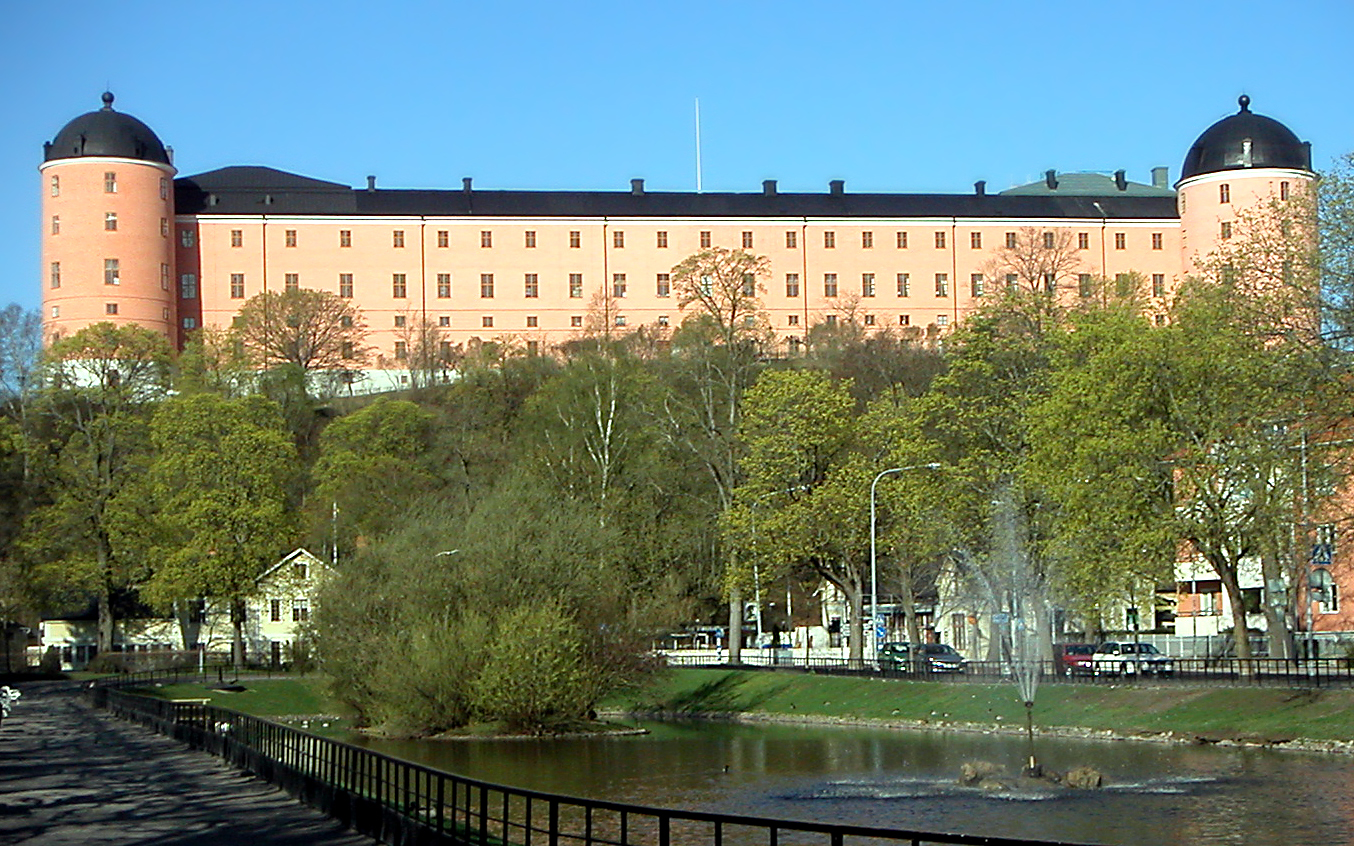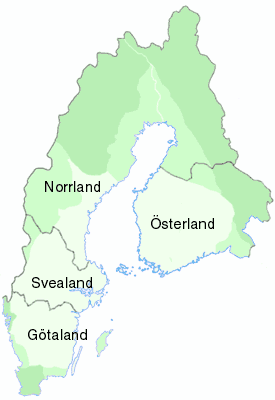|
Svitjod, Old Norse
''Svitjod'' (also spelled Svithiod; , Old Swedish: ''Svethiudh'') was an early name for both the people known as the Svear and the land they inhabited. In medieval times, the name usually referred to their central territory in what is now Uppland in eastern Sweden. The name is composed of the ethnonym ''Svear'' and the word ''*thiudh'', meaning "people". Over time, it was also used more broadly as a poetic or historical name for the whole Swedish kingdom. In Norse literature, ''Svitjod'' could also refer to a vast eastern region, including parts of what is now Russia, known as "Great Svitjod" (see Garðaríki). Geographic scope In the narrower sense, ''Svitjod'' referred specifically to the core territory of the Svear in the Mälaren Valley, primarily in what is now Uppland, and by extension parts of Södermanland and Västmanland. According to Snorri Sturluson, ''Svíþjóð sjálfri'' ("Svitjod proper") was the heartland of the Svear, distinct from the wider realm known as ''S ... [...More Info...] [...Related Items...] OR: [Wikipedia] [Google] [Baidu] |
Uppsala
Uppsala ( ; ; archaically spelled ''Upsala'') is the capital of Uppsala County and the List of urban areas in Sweden by population, fourth-largest city in Sweden, after Stockholm, Gothenburg, and Malmö. It had 177,074 inhabitants in 2019. Located north of the capital Stockholm, it is also the seat of Uppsala Municipality. Since 1164, Uppsala has been the ecclesiology, ecclesiastical centre of Sweden, being the seat of the Archbishop of Uppsala, Archbishop of the Church of Sweden. Uppsala is home to Scandinavia's largest cathedral – Uppsala Cathedral, which was the frequent site of the coronation of the Swedish monarch until the late 19th century. Uppsala Castle, built by King Gustav I of Sweden, Gustav Vasa, served as one of the royal residences of the Swedish monarchs, and was expanded several times over its history, making Uppsala the secondary capital of Sweden during its Swedish Empire, greatest extent. Today, it serves as the residence of the Governor of Uppsala County ... [...More Info...] [...Related Items...] OR: [Wikipedia] [Google] [Baidu] |
Consolidation Of Sweden
Consolidation may refer to: In science and technology * Consolidation (computing), the act of linkage editing in computing * Consolidation (locomotive), popular name of a steam locomotive with a 2-8-0 wheel arrangement * Consolidation (soil), a geological process whereby a soil decreases in volume * Consolidation ratio, the number of virtual servers that can run on each physical host machine * Mathematical consolidation, the fusion of diverse theories into one * Memory consolidation, the process in the brain by which recent memories are crystallised into long-term memory * Pulmonary consolidation, a clinical term for solidification into a firm dense mass * Semiconductor consolidation, the trend of semiconductor companies collaborating * Ultrasonic consolidation, a manufacturing technique for metals In economics * Consolidation (business), the mergers or acquisitions of many smaller companies into much larger ones ** Consolidation (media), consolidation of United States me ... [...More Info...] [...Related Items...] OR: [Wikipedia] [Google] [Baidu] |
Svealand
Svealand (), or Swealand, is the historical core region of Sweden. It is located in south-central Sweden and is one of the three historical lands of Sweden, bounded to the north by Norrland and to the south by Götaland. Deep forests, Tiveden, Tylöskog, and Kolmården, separated Svealand from Götaland. Historically, its inhabitants were called , from which is derived the English 'Swedes'. Svealand consists of the capital region Mälardalen in the east, Roslagen in the north-east, the former mining district Bergslagen in the center, and Dalarna and Värmland in the west. It includes an extensive archipelago of thousands of small islands in Södermanland and Uppland and has lakeshores on the four largest lakes in the country. In the interior, there are several ski resorts in the southern parts of the Scandinavian Mountains. Two large rivers run through Svealand. Klarälven originates in Norway and enters lake Vänern through Värmland, whereas Dalälven runs from ... [...More Info...] [...Related Items...] OR: [Wikipedia] [Google] [Baidu] |
Roden, Sweden
Roden (roðer, "rowing") is the old designation of the coastal areas of Svealand (the yellow areas in the map), that in wartime would man and equip the ships that sailed out in Leidang, ledung. It was not only the eastern part of the province of Uppland that was called "Roden" (called Sæland by Snorri Sturluson) but also other provinces by the Swedish "East sea" (Baltic Sea), like the coastal areas of the province Östergötland. It was called ''roþi'' by Northmen in the 11th century that wrote down the words on the Uppland Runic Inscription 11. The scholarly consensus is that the Rus' people originated in what is currently coastal East Middle Sweden, eastern Sweden around the eighth century and that their name has the same origin as Roslagen in Sweden (with the older name being ''Roden''). According to the prevalent theory, the name ''Rus'', like the Proto-Finnic name for Sweden (''*roocci''). is derived from an Old Norse term for "the men who row" (''rods-'') as rowing was t ... [...More Info...] [...Related Items...] OR: [Wikipedia] [Google] [Baidu] |
Härad
A hundred is an administrative division that is geographically part of a larger region. It was formerly used in England, Wales, some parts of the United States, Denmark, Sweden, Finland, Norway, and in Cumberland County in the British Colony of New South Wales. It is still used in other places, including in Australia (in South Australia and the Northern Territory). Other terms for the hundred in English and other languages include ''wapentake'', ''herred'' (Danish and Bokmål Norwegian), ''herad'' ( Nynorsk Norwegian), ''härad'' or ''hundare'' (Swedish), ''Harde'' (German), ''hiird'' ( North Frisian), ''kihlakunta'' (Finnish), and ''cantref'' (Welsh). In Ireland, a similar subdivision of counties is referred to as a barony, and a hundred is a subdivision of a particularly large townland (most townlands are not divided into hundreds). Etymology The origin of the division of counties into hundreds is described by the ''Oxford English Dictionary'' (''OED'') as "exceedingly obscu ... [...More Info...] [...Related Items...] OR: [Wikipedia] [Google] [Baidu] |
Norrland
Norrland (, , originally ''Norrlanden'', meaning 'the Northlands') is the northernmost, largest and least populated of the three traditional lands of Sweden, consisting of nine provinces. Although Norrland does not serve any administrative purposes, it continues to exist as a historical, cultural, and geographic region; it is often referred to in everyday language, e.g., in weather forecasts. Several related Norrland dialects form a distinct subset of dialects of the Swedish language separate from those to its south. Norrland consists of the majority of the Swedish landmass at about 60% of the land area, but only has about 12% of the country's population. Its largest city is Umeå, while the other four county seats are Gävle, Härnösand, Östersund and Luleå. The largest non-capitals are Sundsvall, Skellefteå and Örnsköldsvik while Kiruna is the largest town of the vast Lapland province in the far north. Sweden's highest mountain Kebnekaise and deepest lake of Hornav ... [...More Info...] [...Related Items...] OR: [Wikipedia] [Google] [Baidu] |
Ledung
The institution known as ''leiðangr'' (Old Norse), ''leidang'' ( Norwegian), ''leding'' ( Danish), ''ledung'' ( Swedish), ''expeditio'' (Latin) or sometimes lething (English), was a form of conscription ( mass levy) to organize coastal fleets for seasonal excursions and in defense of the realm typical for medieval Scandinavians and, later, a public levy of free farmers. In Anglo-Saxon England, a different system was used to achieve similar ends, and was known as the fyrd. The first recorded instance of a Norse lething is disputed among scholars. There is considerable evidence that substantiates its existence in the late 12th century. However, there are also written sources and archeological evidence which indicate that the lething system was introduced as early as the tenth century, if not earlier. Origins The age of the lething is disputed among scholars. The Icelandic sagas link the introduction of the lething to King Haakon I (The Good) of Norway in the tenth century. The fir ... [...More Info...] [...Related Items...] OR: [Wikipedia] [Google] [Baidu] |
Anglo-Saxon England
Anglo-Saxon England or early medieval England covers the period from the end of Roman Empire, Roman imperial rule in Roman Britain, Britain in the 5th century until the Norman Conquest in 1066. Compared to modern England, the territory of the Anglo-Saxons stretched north to present day Lothian in southeastern Scotland, whereas it did not initially include western areas of England such as Cornwall, Herefordshire, Shropshire, Cheshire, Lancashire, and Cumbria. The 5th and 6th centuries involved the collapse of economic networks and political structures and also saw a radical change to a new Anglo-Saxon language and culture. This change was driven by movements of peoples as well as changes which were happening in both northern Gaul and the North Sea coast of what is now Germany and the Netherlands. The Anglo-Saxon language, also known as Old English, was a close relative of languages spoken in the latter regions, and genetic studies have confirmed that there was significant migrat ... [...More Info...] [...Related Items...] OR: [Wikipedia] [Google] [Baidu] |
Hundred (county Division)
A hundred is an administrative division that is geographically part of a larger region. It was formerly used in England, Wales, some parts of the United States, Denmark, Sweden, Finland, Norway, and in Cumberland County in the British Colony of New South Wales. It is still used in other places, including in Australia (in South Australia and the Northern Territory). Other terms for the hundred in English and other languages include '' wapentake'', ''herred'' (Danish and Bokmål Norwegian), ''herad'' ( Nynorsk Norwegian), ''härad'' or ''hundare'' (Swedish), ''Harde'' (German), ''hiird'' ( North Frisian), ''kihlakunta'' (Finnish), and '' cantref'' (Welsh). In Ireland, a similar subdivision of counties is referred to as a barony, and a hundred is a subdivision of a particularly large townland (most townlands are not divided into hundreds). Etymology The origin of the division of counties into hundreds is described by the ''Oxford English Dictionary'' (''OED'') as "exceedingly ... [...More Info...] [...Related Items...] OR: [Wikipedia] [Google] [Baidu] |
Folkland (Swedish Provinces)
The Folklands (Folklanden) is the name for the original Swedish provinces of Tiundaland, Attundaland, Fjärdhundraland, and Roden ( Roslagen) which in 1296 united to form the province of Uppland. They were originally united by electing a common king who administered the sacrifices at Uppsala and who was the commander of the leidang during wars. It is not known when they united for the first time, but already in 98 AD, Tacitus described the Suiones as a powerful tribe. Modern usage The term ''Folkland'', in the transferred sense of originally independent subprovinces, has by modern historians also been used to refer to the similar traditional provinces of the areas which later became the unified provinces of Hälsingland and Småland Småland () is a historical Provinces of Sweden, province () in southern Sweden. Småland borders Blekinge, Scania, Halland, Västergötland, Östergötland and the island Öland in the Baltic Sea. The name ''Småland'' literally means "s ... [...More Info...] [...Related Items...] OR: [Wikipedia] [Google] [Baidu] |




